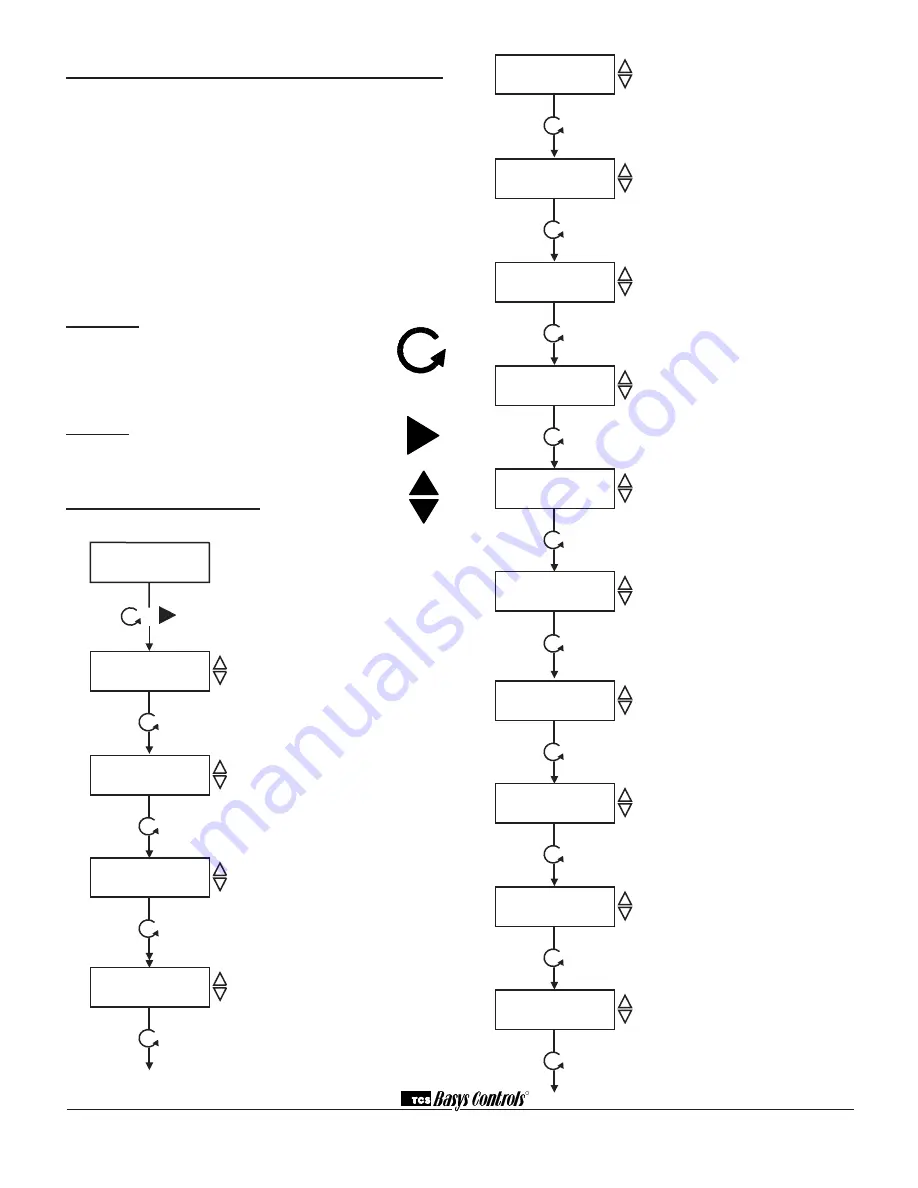
R
2800 LAURA LANE • MIDDLETON, WI 53562 • (800) 288-9383 • FAX (608) 836-9044 • www.tcsbasys.com
3
Programming
The SZ1145 may be programmed through the display
and keypad, or with a PC.
If programming with a PC, the following must be set
through the keypad prior to programming:
• Address (step #2)
• Baud rate (step #3)
For more information on programming through the PC,
consult your TCS software manual.
PROGRAMMING THROUGH THE KEYPAD
To access the programming screens, press both the
“Scroll” and “Next” keys simultaneously.
Scroll Key
- The "Scroll" key is also used to
save any changes to the "current" screen and
advance to the next screen while program-
ming. The "Scroll" key is used to enter the
Programming Mode when pressed with the
"Next" key.
Next Key
- Used to enter Programming Mode
when pressed with the “Scroll” key. Also used to
exit programming without saving changes to the
current screen.
Increment/Decrement Keys
- Used to select the
desired value.
Enable Temp1 Alarm Screen.
Choose
whether or not to enable the Temp1 input
alarm function.
Temp1 Alarm Low Limit Screen.
Enter
a low limit temperature setting. When
the Temp1 input temperature falls to this
value, an alarm will be generated. (This
screen is not shown if the Temp1 alarm
is not enabled.)
Temp1 Alarm High Limit Screen.
Enter
a high limit temperature setting. When
the Temp1 input temperature rises to this
value, an alarm will be generated. (This
screen is not shown if the Temp1 alarm
is not enabled.)
Temp1 Alarm Hysteresis Screen.
Enter
the number of degrees that the tempera-
ture must fall (for a high alarm) or must
rise (for a low alarm) before an existing
alarm condition for the Temp1 input will
be automatically cleared. (This screen
is not shown if the Temp1 alarm is not
enabled.)
Enable Temp2 Alarm Screen.
Choose
whether or not to enable the Temp2 input
alarm function.
Temp2 Alarm Low Limit Screen.
Enter
a low limit temperature setting. When
the Temp2 input temperature falls to this
value, an alarm will be generated. (This
screen is not shown if the Temp2 alarm
is not enabled.)
Temp2 Alarm High Limit Screen.
Enter
a high limit temperature setting. When
the Temp2 input temperature rises to this
value, an alarm will be generated. (This
screen is not shown if the Temp2 alarm
is not enabled.)
Temp2 Alarm Hysteresis Screen.
Enter
the number of degrees that the tempera-
ture must fall (for a high alarm) or must
rise (for a low alarm) before an existing
alarm condition for the Temp2 input will
be automatically cleared. (This screen
is not shown if the Temp2 alarm is not
enabled.)
Enable Temp3 Alarm Screen.
Choose
whether or not to enable the Temp3 input
alarm function.
Temp3 Alarm Low Limit Screen.
Enter
a low limit temperature setting. When
the Temp3 input temperature falls to this
value, an alarm will be generated. (This
screen is not shown if the Temp3 alarm
is not enabled.)
Main Monitoring Screen.
Press the
scroll and next buttons to access the
following screens.
Access Code Entry Screen.
Enter
the access code. If the wrong code
is entered, the program reverts to the
main screen. 248 is the default access
code.
Controller Address Screen.
If using
a PC to access the SZ1145, set a
unique address from 0 to 255, exclud-
ing 248.
Communication Baud Rate Screen.
If using a PC to access the SZ1145,
all controllers on a network must be
set to the same baud rate. Choose
between 2.4K, 4.8K, 9.6K and 19.2K.
Display Type Screen.
Choose
between FAHRENHEIT and CELSIUS
for temperature indication.
ENTER ACCESS
CODE: 000
1.
SET ADDRESS:
000
2.
SET BAUD RATE:
9.6K
3.
ALARM STATUS
CHECK
+
TEMPS SHOWN IN:
FAHRENHEIT
4.
ENABLE TEMP 1
ALARM? NO
5.
TEMP1 ALARM LOW
LIMIT: 60F
6.
TEMP1 ALARM HIGH
LIMIT: 100F
7.
TEMP 1 ALARM
HYSTERESIS 03F
8.
ENABLE TEMP 2
ALARM? NO
9.
TEMP2 ALARM LOW
LIMIT: 60F
10.
TEMP2 ALARM HIGH
LIMIT: 100F
11.
TEMP2 ALARM
HYSTERESIS 03F
12.
ENABLE TEMP3
ALARM? NO
13.
TEMP3 ALARM LOW
LIMIT: 60F
14.


























